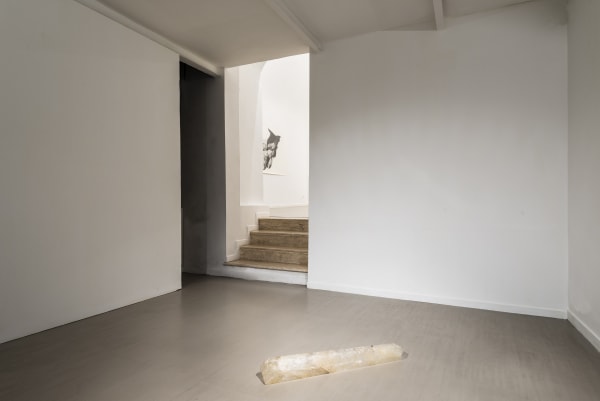Giovanni Kronenberg
GIOVANNI KRONENBERG
With a critic text by Alessandro Rabottini
September 15 > November 8, 2016
A rock crystal and a black pearl, a glass bell jarand a mouflon skin, an ancient press, a large rough sea sponge, crafted malachite, elk antlers: these are just a few of the elements we find in the works that Giovanni Kronenberg gathered for this exhibition. They are elements the artist has collected over time, with which he has lived – sometimes for long periods – before turning them into works. His intervention is often minimal, a minor change or, more often, the addition of an object or incongruous material, as if to encourage the emergence of a quality that the collected elements already possess. Many of Kronenberg’s works – and not only those present in this exhibition – are linked by this leitmotif, by the fact that they are artefacts or rare and hence precious natural finds that tend to be collected. And, as we know, rarity is tied closely to time, as if it descended from it, because in a certain sense rare things are those that have survived. Even possession – like the private collecting of certain artefacts – is a form of desire: the desire to grasp taxonomy, to absorb it, by literally taking home a fragment of the time whence we came but that we will never achieve. Therefore, on one hand we have a time that goes beyond humanity, and on the other human instruments that subdivide, isolate, study and conserve fragments of that time. This stardust is the realm of Kronenberg’s work, in which materials and findings are acquired and then worked, in some cases by highly skilled craftspeople (as in the case of malachite), but that in others are subjected to simple, light alterations. The construction of combinatory grammar underpins Kronenberg’s work, a grammar that acts on the slow sedimentation of the evocative quality inherent in objects and on the subsequent alteration of those qualities through forms of intrusion. The objects and materials that Kronenberg combines are imbued with the past, yet they do not generate narrations; they contain multiple dimensions of time but do not tell stories. They can be defined as “poetic” in the extent to which poetry can be defined as a slow form of chiselling words, starting with the raw material that is interior intuition.
Extracts from the critic text by Alessandro Rabottini
-

Giovanni Kronenberg, installation view at z2o Sara Zanin Gallery Rome
-

Giovanni Kronenberg, installation view at z2o Sara Zanin Gallery Rome
-

Giovanni Kronenberg, installation view at z2o Sara Zanin Gallery Rome
-

Giovanni Kronenberg, installation view at z2o Sara Zanin Gallery Rome
-

Giovanni Kronenberg, installation view at z2o Sara Zanin Gallery Rome
-

Giovanni Kronenberg, installation view at z2o Sara Zanin Gallery Rome
-

Giovanni Kronenberg, installation view at z2o Sara Zanin Gallery Rome
-

Giovanni Kronenberg, installation view at z2o Sara Zanin Gallery Rome
-

Giovanni Kronenberg, installation view at z2o Sara Zanin Gallery Rome
-

Giovanni Kronenberg, installation view at z2o Sara Zanin Gallery Rome
-

Giovanni Kronenberg, installation view at z2o Sara Zanin Gallery Rome
-

Giovanni Kronenberg, installation view at z2o Sara Zanin Gallery Rome
-
 Giovanni Kronenberg, L’antinomia di Capitan Blicero, 2016
Giovanni Kronenberg, L’antinomia di Capitan Blicero, 2016 -
 Giovanni Kronenberg, Untitled , 2016
Giovanni Kronenberg, Untitled , 2016 -
 Giovanni Kronenberg, Untitled , 2016
Giovanni Kronenberg, Untitled , 2016 -
 Giovanni Kronenberg, Cinetico anche nella stasi, 2016
Giovanni Kronenberg, Cinetico anche nella stasi, 2016 -
 Giovanni Kronenberg, Parlando sottovoce si attivano stati di coscienza che pensavamo di non avere, 2016
Giovanni Kronenberg, Parlando sottovoce si attivano stati di coscienza che pensavamo di non avere, 2016 -
 Giovanni Kronenberg, Untitled , 2016
Giovanni Kronenberg, Untitled , 2016




















